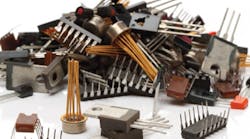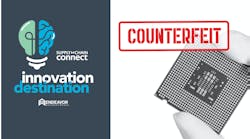By Steve Martin
Global Purchasing has recently reported on the ongoing danger that counterfeit components pose to mission-critical industries. While awareness of counterfeits is increasing and regulators are responding, purchasing professionals continue to be concerned about how to combat this problem and require more information to help them identify and avoid counterfeits. Consider the following statistics from those articles, as identified in Global Purchasing’s Counterfeit Components Survey released last year:
- 87% of respondents agree that the danger of counterfeit components extends beyond military and aerospace industries into commercial markets
- Only 47% of respondents believe that Senate hearings and the resulting National Defense Authorization Act will reduce the threat of counterfeits
- 70% are concerned about the government’s ability to fight the counterfeit threat
- Not surprisingly, given the above responses, 54% of respondents to another Global Purchasing survey said they need help in identifying quality supply sources, and 50% need training and education in identifying counterfeit parts
So the old saying caveat emptor applies, as buyers know there is a problem, don’t have much faith that the government will help them, and want to better educate themselves on how to identify and avoid counterfeit parts. How do buyers know the difference between 100% factory authorized and counterfeit components? And if counterfeit parts are identified in the supply chain, how can purchasers overcome obstacles to report counterfeit parts and hold counterfeiters accountable?
Distinguishing real from fake requires a trained eye
Most counterfeit parts are not easily distinguishable from authentic components. Still, design engineers and purchasing professionals should familiarize themselves with the five most commonly used methods for counterfeiting electronics components:
- Empty shells. These are chips that have the same external form factor and top marks as authentic parts, but are empty inside. Since they are the most easily detectable, counterfeiters have increasingly turned to less easily detectable methods.
- Pulls. Pulls may be legitimate parts that have been recycled and repackaged as new, authentic parts, often becoming damaged in the process. Printed circuit boards are heated so that the chips can be more easily ‘pulled’ off, which can cause problems when utilized in production.
- Blacktopping. This is a process in which a thin black epoxy coating is applied to the top of a component so that a new part number and date code can be printed on it. Because the blacktopped part has the same dimensions as the one it is intended to copy, it usually passes visual inspection.
- Uninspected/untested parts. These are legitimate components, not counterfeits, but are equally dangerous. They are manufactured on the same assembly line as authentic parts, but do not go through the manufacturer’s inspection and testing process.
- Sample/scrap parts. These are also legitimate components which have been discarded because they are obsolete products, test failures or excess inventory. “Dumpster divers” make a business of retrieving these components and reselling them. They are also difficult to distinguish.
If the counterfeit part is not detected and makes its way into the supply chain, the results can vary. Some items won’t work at all, while others’ performances may degrade over time. The worst outcome is an abrupt and catastrophic failure of a counterfeit part, so it is essential for purchasing professionals to identify and report any counterfeits.
Reporting counterfeit parts
Reporting is essential to help authorities identify and prosecute counterfeiters. Procurement and design engineers need to be educated about what to do should they buy something that is not as expected. Unfortunately, it’s not always easy to get supply chain participants to cooperate in reporting counterfeits. The Government Industry Data Exchange Program (GIDEP) is a cooperative government-industry group that is tasked with sharing technical information to help reduce waste and avoid unnecessary expense. GIDEP has been instrumental in the fight against counterfeits, especially given its roots in the defense industry, which has been significantly affected by the spread of counterfeits. When surveying members on the obstacles to reporting counterfeit parts, GIDEP found that many respondents were: fearful of legal liability issues or lawsuits by third parties, and perhaps more damaging, that many organizations prohibit the reporting of counterfeits or other non-conforming materials to outside parties.
This fear of liability creates a shadow area where companies write off the wasted time and financial resources spent on counterfeits, thereby enabling the counterfeiters to continue to flourish. GIDEP subsequently conducted an experiment in late 2010 to see whether or not purchasing professionals fearing liability would increase reporting of counterfeits if the requirement to name the supplier(s) involved in the sale of the suspect counterfeit parts was removed. This did not result in a significant increase in reporting. In addition to GIDEP, industry groups such as the Independent Distributors of Electronics Association (IDEA) and the Electronics Resellers Association, Inc. (ERAI), are contributing to the effort to make reporting counterfeits easier and more transparent. ERAI, for example, provides an online form on its website via which people can report anonymously.
Despite these efforts, regulators have realized that government action is necessary to control the spread of counterfeits. The 2012 National Defense Authorization Act eliminated this alleged barrier in order to encourage reporting by shielding purchasing professionals and their organization from being subject to civil liability based on reporting a suspect counterfeit part. With less than a year in effect this change has not appreciably increased reporting, the avoidance of which is perhaps too ingrained in the purchasing culture to change rapidly. Reporting is an important tool in the fight to combat this problem. The failure of a company to report a counterfeit part finding via GIDEP will no doubt increase the risk that other companies will inadvertently buy counterfeit parts.
While education to be able to identify counterfeits and the willingness to report counterfeits both slowly increase, the purchasing professional’s best line of defense is to avoid questionable sources in the open market in favor of obtaining authentic parts from manufacturer-direct distributors. These distributors operate with established process controls, and are certified to ISO 9001, ISO 14001 and ESD 20:20 standards for warehousing and handling procedures. Franchised distributors possess the certified, standards-based infrastructure and experience in meeting the needs of purchasing professionals trying to avoid counterfeits. The best guarantee against counterfeit parts is 100% direct traceability from the original manufacturers, eliminating the risks surrounding product quality, reliability and liability.
Steve Martin is executive vice president of sales for Components Direct, a factory-authorized source for excess and end-of-life semiconductor components based in San Jose, Calif. Components Direct is a franchised distributor and guarantees 100% direct manufacturer traceability on all parts. The company’s sophisticated "G2" analytics platform provides suppliers with visibility and control of the secondary market. Armed with detailed secondary market data by region, date code and vendor, suppliers can better mitigate risk, maximize revenue and protect their brand.








